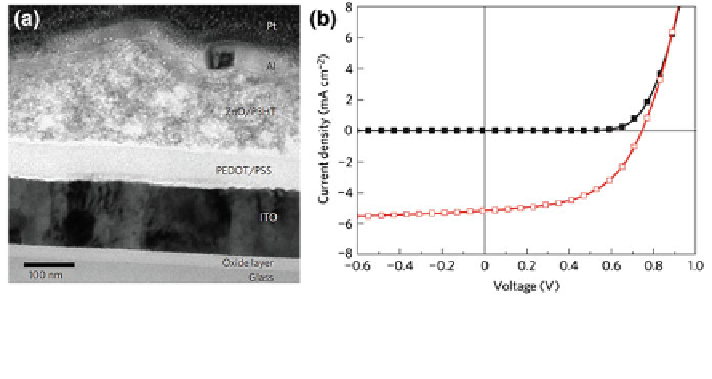Environmental Engineering Reference
In-Depth Information
Fig. 9.7 a TEM image of the cross-section of a ZnO/P3HT device; b J-V characteristics of the
best device obtained in dark (black) and under simulated illumination (red). Reproduced with
permission from Ref. [
30
]
[
14
,
69
], it is notable that when they were in situ synthesized in the presence of
P3HT, a 2.9 % PCE was obtained [
69
].
Apart from Cadmium Chalcogenide nanorods, TiO
2
nanorods were also widely
used for fabricating HSCs. As mentioned before, the synthesis of soluble TiO
2
nanorods requires the treatment of long chain surfactants which would act as
insulating layers and reduce the device performance [
64
]. Chang et al. [
70
] were
able to remove the insulating surfactant through ligand exchange technique and an
improvement of the PCE from 0.4 to 1.14 % was achieved with P3HT as donor.
Recently, the same group reported a respectable PCE of 2.2 % by modifying the
surface of TiO
2
nanorods with interfacial modifiers [
65
]. In the case of ZnO, little
papers focused on the blend of ZnO nanorods and conjugated polymers [
71
] while
the ZnO nanorod arrays were most studied and we will discuss this issue in detail
in the following section.
We have mentioned in the above section that the main challenges for porous
film formed by nanoparticles are the efficient infiltration of polymers into the
inorganic network and the optimization of polymer/nanocrystal interface. Except
for using the blend of the two materials, another solution to these problems could
be electrospinning, a technique that has been widely used for preparing high
aspect-ratio nanowires and highly porous films [
72
-
74
]. The pore size, porosity
and the film thickness could be easily tailored for polymer infiltration while the
high aspect ratios of the nanowires guarantee the large interfacial area for efficient
charge separation and the continuous charge transport paths. Admirable conver-
sion efficiencies of the devices based on electrospun TiO
2
[
22
,
75
,
76
] or ZnO [
31
]
nanofibrous networks and P3HT have been reported (see Fig.
9.9
). This technique
seems to be a promising way to prepare large area, low cost and efficient HSCs.

Search WWH ::

Custom Search